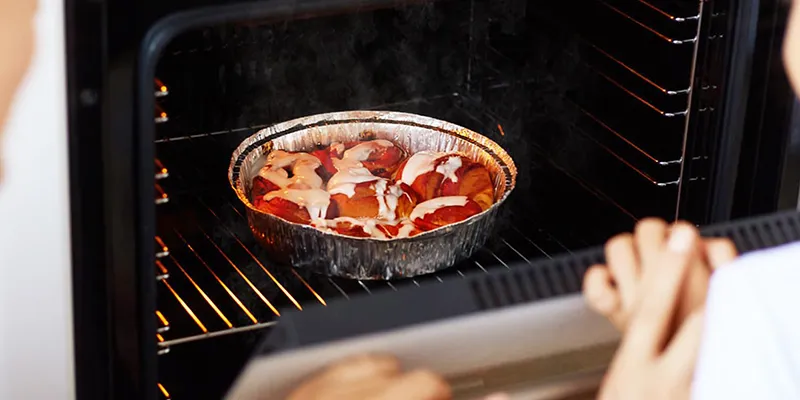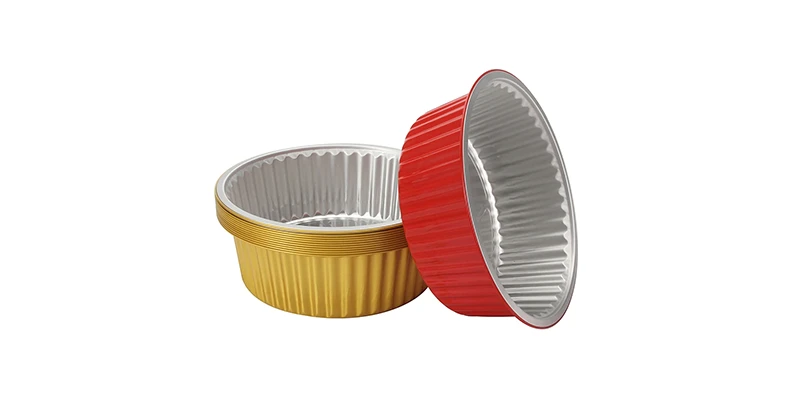When it comes to cooking in a microwave, safety is of utmost importance. With the rise of microwaves in the 1950s, concerns about the safety of cooking with these devices have been a topic of debate. One of the most common questions about microwave cooking is whether round foil pans are safe to use.
For decades, foil pans have been a kitchen staple, with aluminum being the most commonly used material. Due to rising health concerns around aluminum, many manufacturers now use alternatives like stainless steel and ceramic. These modern materials offer safer and more durable options for microwave cooking.

Why Are Round Foil Tray Considered Risky In Microwave
Aluminum foil pans pose risks in microwaves due to the arcing effect. Microwaves generate electromagnetic waves that interact with conductive metals, creating concentrated electric currents. These currents cause sparks (arcing), which can damage the microwave’s interior, ignite fires, or unevenly heat food.
The round shape foil pans amplify this risk, as curved edges concentrate energy. The FDA and USDA explicitly warn against using metal containers in microwaves unless they are labeled “microwave-safe” by manufacturers. Always verify product specifications before use.
Why Is Round Foil Pan So Popular
Stainless steel and ceramic containers are reusable, but round aluminum foil pans offer superior benefits: lightweight, portable, affordable, and disposable. Perfect for large events and outdoor use.
Round aluminum foil pans usually have a flat bottom, curved sides, and a rim to prevent spills. They can withstand high temperatures, are suitable for use in the oven, and can withstand higher cooking temperatures.
Basics of Microwave Safety
Microwaves generate heat by emitting electromagnetic waves to stir the water molecules in food. This fast, efficient cooking method works best with durable cookware materials.
Common microwave-safe materials include glass, ceramics, and certain plastics. These materials can withstand the heat generated without causing adverse reactions, making them the first choice for microwave cooking.
Microwave-safe aluminum foil containers are specially coated to block electromagnetic wave interference, ensuring safe microwave use.
Can You Microwave Aluminum Pan If They’re Labeled “Microwave-Safe”
Yes—if and only if the packaging includes a “microwave-safe” certification. Reputable manufacturers design such pans with protective coatings or layered materials to suppress arcing. For instance, some brands apply a non-conductive polymer layer to isolate the aluminum from microwave energy.

However, even certified pans require precautions:
- Avoid crumpled or damaged pans (creases intensify arcing).
- Keep the pan centered, away from microwave walls.
- Use medium power settings and shorten heating intervals.
- Never operate an empty foil pan, as residual energy may overheat it.
What Happens If You Accidentally Microwave a Regular Foil Pan
Immediately stop the microwave if you notice sparks, smoke, or unusual noises. Carefully remove the pan (use oven mitts—it may be superheated) and inspect the microwave for damage. Minor arcing may leave scorch marks but won’t necessarily ruin the appliance. However, repeated incidents can degrade the magnetron (the microwave’s core component). For safety:
- Unplug the microwave and let it cool.
- Clean any residue with a damp cloth.
- Test the microwave afterward by heating a glass of water for 1 minute. If functional, continue use; if not, consult a technician.
Microwave Dilemma
Can Metal Go in the Microwave?
The short answer is generally no. Metal can reflect microwaves, potentially leading to sparks or even fires.

The Science Behind Microwave and Metal Interaction
When microwaves encounter metal, they can create arcing, where electric discharges leap between the metal and the microwave walls. This phenomenon can damage both the microwave and the metal object.
Round Foil Pans: An In-Depth Look
Round foil pans are designed for baking, such as pies and cakes. The round shape allows for even heat distribution.
Several brands produce round foil pans, each with unique features such as strength, depth, and coating. Well-known brands include Reynolds and EZ Foil, which offer different designs to suit different cooking needs.
Microwave-safe round foil pans require compatible microwave wattage, proper pan dimensions, and suitable food types for safe heating.
Are There Microwave-Safe Alternatives to Aluminum Foil Pans
Absolutely. Opt for these alternatives when reheating or cooking:
- Glass Containers: Borosilicate glass resists thermal shock and distributes heat evenly.
- Ceramic Dishes: Ensure they’re glaze-free (metallic finishes can cause arcing).
- Silicone Molds: Flexible, non-reactive, and tolerate temperatures up to 428°F (220°C).
- Microwave-Safe Plastic: Look for “BPA-free” labels and avoid warped containers.
- For disposable needs, choose parchment-lined paper trays or plant-fiber containers.
Tips for Using Round Foil Pans In Microwave
If using a foil pan, make sure it is clearly labeled as microwave-safe. Even then, be careful and monitor the cooking process.
You can use glass or ceramic containers for microwave cooking instead of aluminum foil containers. These materials can withstand high temperatures without the risks that metal poses.

While foil pans are ideal for oven-to-table transitions, never transfer them directly to microwaves. Instead:
- Cool Down: Let the pan reach room temperature to avoid thermal shock.
- Transfer Food: Move contents to a microwave-safe dish using a spatula.
- Partial Reheating: If unavoidable, use the microwave’s “defrost” setting at 30% power and monitor closely.
This two-step process prevents material fatigue in foil pans and minimizes safety hazards.
What Do Leading Manufacturers Recommend for Microwave Use
Industry leaders like Reynolds and Nordic Ware emphasize:
- Check Labels: Only use pans explicitly marked for microwave use.
- Avoid High-Fat Foods: Greasy foods reach higher temperatures, increasing arcing risks.
- Vent Covers: Loosely tent pans with microwave-safe wax paper to prevent splatters.
- Time Limits: Never exceed 2–3 minutes per session; stir food between intervals.
How to Dispose of Foil Pans After Microwaving
Recycle foil pans if they’re unpainted and clean. Scrunch the pan into a ball—if it springs back, it’s aluminum. However, pans contaminated with food waste or microwave-induced burns belong in general trash. For eco-conscious users, switch to reusable silicone or stainless-steel containers to reduce waste.



